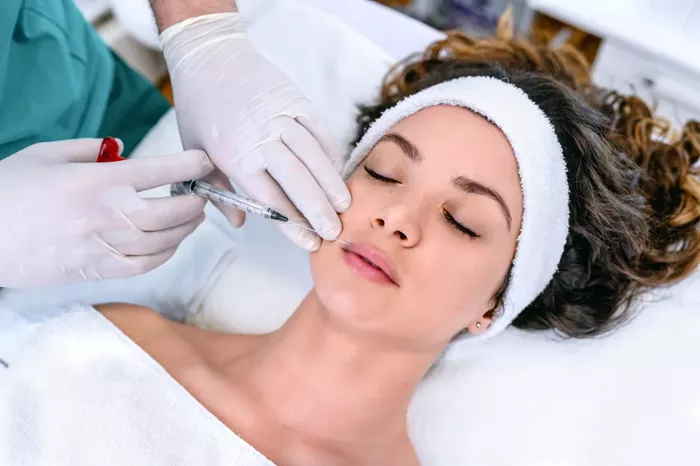Since the 1980s, many celebrities have turned to cosmetic fillers to maintain a youthful appearance. However, as numerous before-and-after photos reveal, the use of fillers can easily become excessive. Recently, public figures such as Kristin Davis, Courteney Cox, and Olivia Culpo have attracted attention for opting to dissolve their injectables in favor of a more natural look.
This shift has sparked a growing interest in filler alternatives or complementary treatments that refresh the skin without the characteristic puffiness associated with traditional fillers. Dr. Shawn Seit, founder and medical director of Rejuuv Medi Spa, emphasizes the effectiveness of biostimulators in achieving tight, youthful skin. In essence, biostimulators are treatments that encourage the skin to rejuvenate itself by activating fibroblasts, the cells responsible for collagen and elastin production—key components that provide skin with firmness and elasticity. Unlike dermal fillers, which offer immediate volume, biostimulators gradually enhance skin quality by promoting the body’s natural tissue regeneration, according to dermatologist Dr. Julia Carroll, co-founder of Compass Dermatology.
Understanding Biostimulators: What Are They?
Biostimulators are primarily known by brand names such as Radiesse and Sculptra, both of which are the only synthetic biostimulators approved for injection by Health Canada. Radiesse, approved in 2005, contains calcium hydroxylapatite (CaHA) and was originally utilized as a conventional dermal filler. In contrast, Sculptra, approved in 2006, consists of poly-L-lactic acid (PLLA) and is delivered in a sterile water carrier. While both treatments stimulate collagen and elastin production to enhance skin firmness and provide subtle volume, they offer less immediate volume compared to hyaluronic acid fillers, which remain the preferred choice for enhancing features like the lips.
Treatment Applications and Areas of Focus
Dr. Seit notes that biostimulators can be applied to nearly any area, with the face, neck, décolletage, and backs of the hands being the most common. Within the facial area, biostimulators can define the cheeks, enhance the jawline, and address hollowness in areas like the temples, nasolabial folds, and marionette lines. Additionally, they can be utilized on sagging skin in areas such as the knees, elbows, or abdomen. Both Radiesse and Sculptra may be used in the same session, tailored to the specific needs of the targeted area.
Who Can Benefit from Biostimulator Injections?
Biostimulators are particularly beneficial for individuals in their 30s, 40s, or 50s seeking to enhance their skin’s overall appearance. Dr. Seit explains that collagen production declines by 1-2% annually after age 22, resulting in fine lines, minor laxity, and reduced radiance—issues that biostimulators effectively address by stimulating fibroblast activity.
However, individuals seeking immediate results, such as before a wedding or school reunion, should note that biostimulators typically take eight to 12 weeks to show visible improvements. Furthermore, those in their early twenties with already youthful skin may not require such treatments, as their fibroblasts are functioning optimally. Conversely, older individuals with significantly lax skin may need multiple treatments for noticeable results, as their collagen production may be substantially diminished.
The Treatment Process
Biostimulators like Sculptra and Radiesse are administered via needle or cannula, with the injection process lasting approximately 15 to 30 minutes. Needles are generally employed for precise applications, while cannulas distribute the product over broader areas.
Pain Management and Recovery
Most patients find biostimulator injections manageable, as the solutions are often mixed with lidocaine to numb the injection site. Some clinics may also apply numbing cream beforehand, and additional options like laughing gas or vibrating tools may be available for those with heightened sensitivity. While minor tenderness may occur at the injection sites, patients can typically return to work immediately after the procedure.
Treatment Frequency and Cost
The frequency of biostimulator injections depends on individual skin quality, age, and desired outcomes. Some may benefit from a single session every year or two, while others might require two to three sessions spaced four to eight weeks apart, followed by annual maintenance appointments. The cost of biostimulator treatments ranges from $1,200 to $1,800 per session, depending on the size of the treated area. Clinics may also offer package deals for multiple sessions.
Biostimulators vs. Fillers: A Combined Approach
Choosing between biostimulators and traditional fillers is not an either/or scenario. Many treatment providers incorporate both into their services. A new category of “hybrid injectables” that combine biostimulators like calcium hydroxyapatite with dermal fillers, such as Ellansé and HArmonyCa, is emerging but is not yet available in Canada. Dr. Carroll notes that HArmonyCa is anticipated soon, describing it as a highly anticipated addition to the market.
In practice, many physicians continue to combine biostimulators for collagen stimulation with hyaluronic acid fillers for volumization, although this approach is considered off-label.
Conclusion
As interest in natural and gradual approaches to skin rejuvenation grows, biostimulators are becoming an increasingly popular option. Consulting with a qualified practitioner skilled in various treatment modalities will help individuals find the best combination of biostimulators, fillers, and other treatments to meet their unique skin care needs. The allure of youthful, beautiful skin often comes with a significant financial commitment, a luxury that many celebrities can easily afford.
Related topic:
How Can I Rebuild Collagen in My Face?
How to prevent skin aging and wrinkles naturally?
How Long Does Skin Tightening Last?


